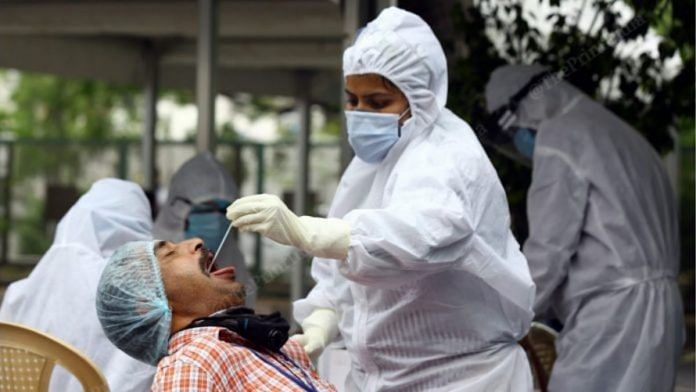New Delhi: The transport of virus-laden air droplets to deep lung could increase with decreasing breathing frequency, a new IIT study has found.
The study, by researchers at the Indian Institute of Technology Madras, revealed that holding breath or having a low breathing rate can increase chances of viruses, like Covid-19, that are airborne of depositing in the lungs.
Some people have a lower breathing rate due to biological factors or because they have been trained to do so, such as yoga experts or athletes. Normal respiration rate for an adult person at rest ranges from 12 to 16 breaths per minute.
The study, published in Physics of Fluids journal, was conducted to develop better therapies and drugs for respiratory infections.
It was led by Professor Mahesh Panchagnula, Department of Applied Mechanics, IIT Madras, and his research scholars Arnab Kumar Mallik and Soumalya Mukherjee.
Also read: Who all will get vaccines free? When will they hit stores? 4 Covid questions on every mind
The study
Airborne infections such as SARS-CoV-2 spread rapidly through tiny air droplets released during sneezing and coughing.
The IIT Madras research team imitated the droplet dynamics in the lung by studying the movement of droplets in small capillaries, which were similar in diameter to bronchioles.
Bronchioles are air passages inside the lungs that branch off like tree limbs from the bronchi (two airways in lungs). They deliver air to tiny sacs called alveoli where oxygen and carbon dioxide are exchanged.
The team generated aerosols from a liquid containing water and fluorescent particles. These fluorescent aerosols were used to track the movement and deposition of particles in the lungs.
They found that the deposition is inversely proportional to the aspect ratio of capillaries, which suggests that the droplets are likely to deposit in longer bronchioles.
According to Panchagnula, “Our lungs have a branched structure, it has got bronchioles that are dichotomously branched. This means each bronchiole branches into two and these go on for 23 generations. The deeper generations, 17 to 23, is where the aerosols meet the blood.”
Speaking to ThePrint, he said: “Deep lung infections are the most dangerous and the question to ask is how do these aerosols reach so deep into the lung and how does it get there in some people and not others. Our research answers the second question, that is, there are some people with dilated bronchioles and these people are the ones who are the most affected.”
The professor added: “Whenever a respiratory disease affects a person the aerosol first settles in the nasal cavity. When the disease worsens, it means the virus colony has been transported to the deep lung. The process of this journey of the aerosol is still unknown and our team will continue to work on finding answers to this.”
Also read: Pfizer says couldn’t attend Modi govt meetings on its vaccine due to ‘extremely’ short notices



